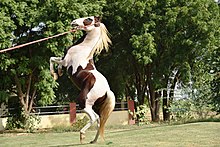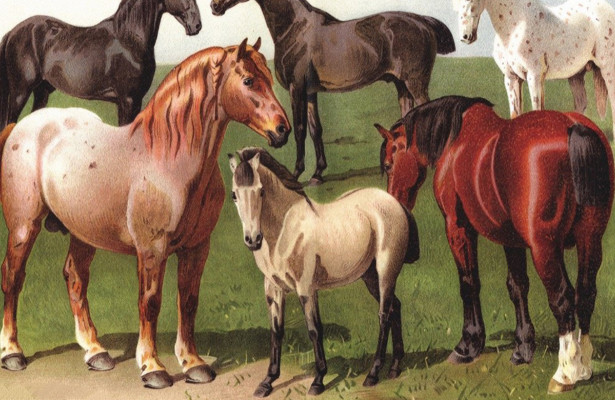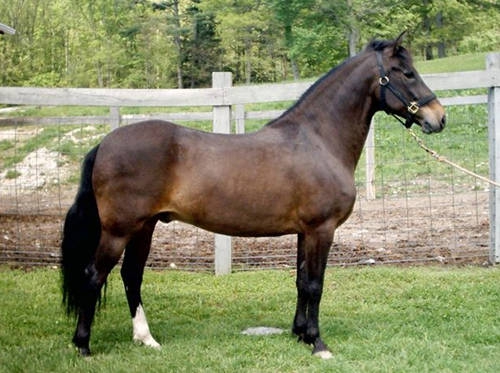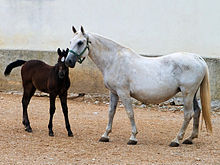Icelandic horse
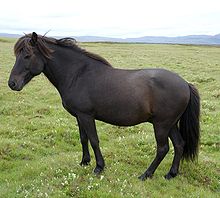 Icelandic horse is a breed of horse raised in Iceland. Its characteristic features are small stature (up to 144 cm at the withers), stocky and rough, large head, shaggy dense bangs, long mane and tail. The colors of horses can be different – for example, red, bay, gray, black, pie. No blunt horses. Icelanders themselves count up to a hundred variations and shades of colors.
Icelandic horse is a breed of horse raised in Iceland. Its characteristic features are small stature (up to 144 cm at the withers), stocky and rough, large head, shaggy dense bangs, long mane and tail. The colors of horses can be different – for example, red, bay, gray, black, pie. No blunt horses. Icelanders themselves count up to a hundred variations and shades of colors.
Icelandic horses should not be confused with ponies, despite their similarities.
Icelandic horses reach maturity late – at 7-8 years, but live long – up to 40 years. Grown in the so-called. herd breeding, in the fresh air. Only with the onset of winter they are driven into shelter. Horses are not afraid of cold weather, as they are overgrown with thick dense coat, and rarely get sick.
The peculiarity of horses is that they are five-aural. They own three main gait – step, trot and gallop, as well as the amble – skade (ISL. Skeið, flugskeið) and Telt (ISL. Tölt) – a four-stroke fast allure (the front legs make step movements, and the rear ones move far forward, which allows horses move forward vigorously).
Icelandic horses are very smart. Thanks to a well-developed equilibrium, obstacles such as ice, sharp rocks or fast rivers can easily be overcome. Character – calm, friendly. Due to the fact that throughout their history horses have not met with predators, they are not afraid of a person and trust him.
A rather medium-sized head with a straight profile and a somewhat shortened front part, small ears, a relatively short, low-set neck, deep chest, elongated massive body, sloping powerful croup, short strong legs with neat strong hooves. The hairline is long, the brushes are short but stiff, the mane and tail are long and very thick. The tail is usually set high. Average measurements: height at the withers – 132 cm; chest girth – 160 cm; metacarpal circumference – 17 cm.
Height at the withers – 130-145 cm. Weight – 380-410 kg.
Story
The breed was introduced to Iceland by the Vikings in the 9th-10th centuries. To save space on dragrakars, the Vikings chose only stunted horses – hence the characteristic sign of the breed. In Scandinavian mythology, horses were revered, and the Icelandic breed, according to legend, came from the eight-legged horse Sleipnir, assistant to the supreme god Odin.
Horses played a big role in the life of the island, as together with boats they were the only means of transportation. They were also used in agricultural work. Mention of the breed is found in numerous literary and historical works. In addition, horses were burned at the funeral pyres, so that they, along with the deceased owners, moved into the afterlife. One of the Viking’s entertainments was the deadly fighting of stallions.
In 982, althing passed a law prohibiting the import of horses into the country. This was done to prevent disease. Since then it has not been permitted to import horses that were previously taken out of Iceland. For example, a horse taken outside the island – even for a performance at the World Equestrian Championships – cannot go back. [1] The ban applies to things used when working with horses – clothes, ammunition. Thanks to this, it was possible to maintain the purity of the breed.
At the end of the XVIII century, a significant part of Icelandic horses died as a result of a volcanic eruption.
In 1904, the first Icelandic breed community was created.
Today Icelandic horses are extremely popular in Europe and North America. The breeding organization, The International Federation of Icelandic Horse Associations, is represented in 19 countries.
Icelandic horses are used for various purposes: for work in the fields, hunting, horseback riding, hippotherapy, equestrian disciplines – from show jumping and speed runs to horse racing, available only to this breed. Horses are ideal for family activities or children’s sports.

